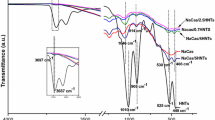Abstract
Fabrication of silver nanoparticles-loaded chitosan-polylactic acid-based films was successfully employed for investigating the effect and interaction factors that affect the tensile strength and elongation at break responses. The two factors were the concentration of polyethylene glycol (PEG) 400 and the ratio of polylactic acid (PLA)/chitosan. Analysis of results was performed by using two-level full factorial design (FFD) to avoid the traditional one-factor-at-a-time experiments, and the model constructed by FFD resulted in improved response, reduced process variability, and closer confirmation of response to targeted requirements. Common statistical tools such as analysis of variance (ANOVA), Pareto chart, normal probability plot of the residuals, and main effect plot with its response were used to determine the most important process variables affecting tensile strength and elongation at break responses. The use of FFD allowed for identification of the most significant parameters under tested conditions. From the results of statistical analysis, it could be concluded that both the concentration of polyethylene glycol (PEG) 400 and the ratio of polylactic acid (PLA)/chitosan had significant effect on tensile strength and elongation at break responses. Therefore, the concentration of polyethylene glycol (PEG) 400 and the ratio of polylactic acid (PLA)/chitosan content in the blend films were employed for a surface analysis design in order to achieve an optimal quality of film based on tensile strength and elongation at break responses. From Table 90.1, the standard order 15 (A = 15 %, B = 50/50) showed the best results in tensile strength and elongation at break which are 8.27376 Mpa and 23.4974 %, respectively. The results from FFD could be studied further expanded to a central composite design, in order to fit the measured data to a quadratic model and to calculate response surfaces.
Access this chapter
Tax calculation will be finalised at checkout
Purchases are for personal use only
Similar content being viewed by others
References
Lagaron, J. M., & Lopez-Rubio, A. (2011). Nanotechnology for bioplastics: Opportunities, challenges and strategies. Trends in Food Science & Technology, 22(11), 611–617.
Wei, D., Sun, W., Qian, W., Ye, Y., & Ma, X. (2009). The synthesis of chitosan-based silver nanoparticles and their antibacterial activity. Carbohydrate Research, 344(17), 2375–2382.
Shaari, A., Seman, M. N. A., & Ku, C. K. M. F. C. (2012). Silver nanoparticles (AgNPs)-loaded chitosan-polylactic acid (PLA) based films: Fabrication and antimicrobial properties. Proceedings of International Conference on Chemical and Biochemical Engineering, Kuala Lumpur, 3–5 Dec 2012.
Ste, G., Copinet, A., & Coma, V. (2006). Novel biodegradable films made from chitosan and poly (lactic acid) with antifungal properties against mycotoxinogen strains. Chemical Engineering Journal, 65, 185–193.
Mayer, J. W. V. A., Bailey, S. J., Baldini, N. C., Emery, S., Ermigiotti, J., Huffman, B., Olcese, M. A., Peters, K. A., Rosiak, J. L., Terruso, D. A., & Whealen, E. A. (2007). ASTM packaging standards and related technical material (7th ed.). West Conshohocken: ASTM International.
Gottipati, R., & Mishra, S. (2010). Process optimization of adsorption of Cr(VI) on activated carbons prepared from plant precursors by a two-level full factorial design. Chemical Engineering Journal, 160(1), 99–107.
Bhavsar, M. D., Tiwari, S. B., & Amiji, M. M. (2006). Formulation optimization for the nanoparticles-in-microsphere hybrid oral delivery system using factorial design. Journal of Controlled Release: Official Journal of the Controlled Release Society, 110(2), 422–430.
Fangueiro, J. F., Andreani, T., Egea, M. A., Garcia, M. L., Souto, S. B., & Souto, E. B. (2012). Colloids and surfaces B: Biointerfaces experimental factorial design applied to mucoadhesive lipid nanoparticles via multiple emulsion process. Colloids and Surfaces B: Biointerfaces, 100, 84–89.
Pongstabodee, S., Monyanon, S., & Luengnaruemitchai, A. (2012). Applying a face-centered central composite design to optimize the preferential CO oxidation over a PtAu/CeO2–ZnO catalyst. International Journal of Hydrogen Energy, 37(6), 4749–4761.
Alqadi, A. N. S., Mustapha, K. N. B., Naganathan, S., & Al-Kadi, Q. N. S. (2012). Development of self-compacting concrete using contrast constant factorial design. Journal of King Saud University – Engineering Sciences, 3(1), 201–205.
Acknowledgment
The research work was financially supported through the short-term grant RDU 110325. Appreciation is also expressed to the Ministry of Higher Education of Malaysia for supporting this study (MyBrain15). The authors are thankful to all technical staffs of Chemical Engineering Research Laboratory for providing the necessary facilities, constant guidance, and encouragement.
Author information
Authors and Affiliations
Corresponding author
Editor information
Editors and Affiliations
Rights and permissions
Copyright information
© 2014 Springer Science+Business Media Singapore
About this paper
Cite this paper
Aznizan, S., Seman, M.N.A., Faizal, C.K.M. (2014). Study of the Effects and Interaction of Operational Parameters on the Fabrication of Silver Nanoparticles (AgNPs)-Loaded Chitosan-Polylactic Acid-Based Films Using Full Factorial Design. In: Kasim, A., Wan Omar, W., Abdul Razak, N., Wahidah Musa, N., Ab. Halim, R., Mohamed, S. (eds) Proceedings of the International Conference on Science, Technology and Social Sciences (ICSTSS) 2012. Springer, Singapore. https://doi.org/10.1007/978-981-287-077-3_90
Download citation
DOI: https://doi.org/10.1007/978-981-287-077-3_90
Published:
Publisher Name: Springer, Singapore
Print ISBN: 978-981-287-076-6
Online ISBN: 978-981-287-077-3
eBook Packages: Humanities, Social Sciences and LawSocial Sciences (R0)




